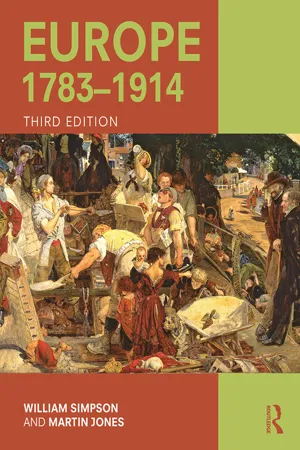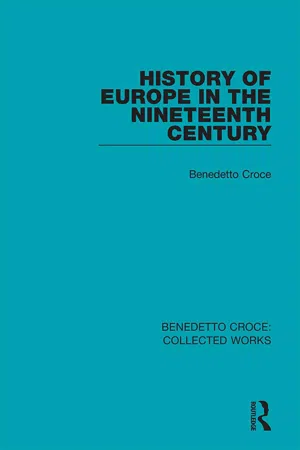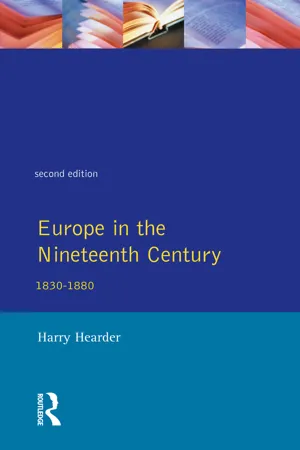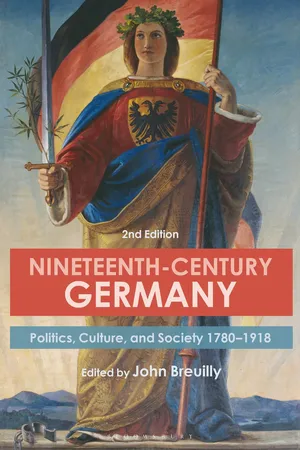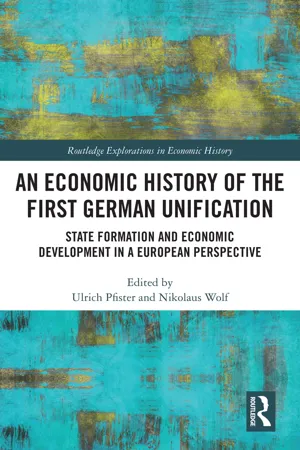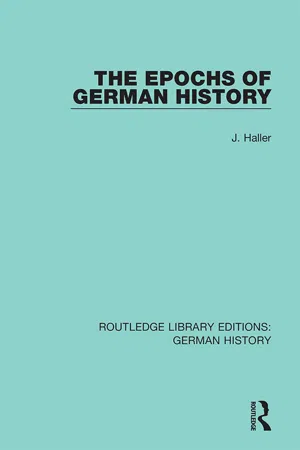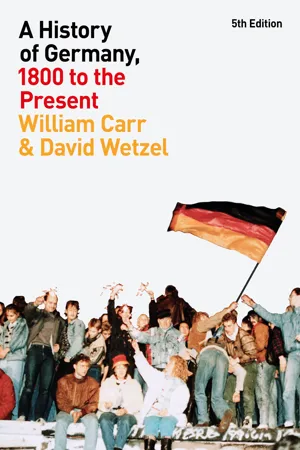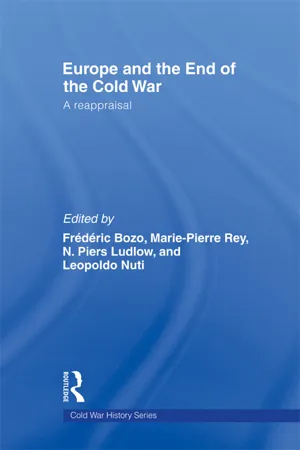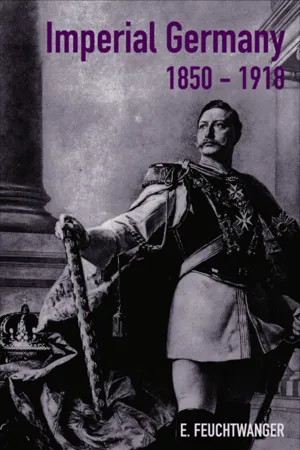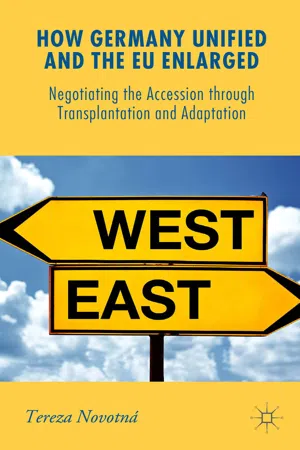History
The German Unification
The German Unification refers to the process by which the various independent states of Germany were unified into a single nation-state in the 19th century. This was largely achieved through the leadership of Otto von Bismarck, who utilized diplomacy and military force to bring about unification. The resulting German Empire emerged as a powerful and influential force in Europe.
Written by Perlego with AI-assistance
Related key terms
11 Key excerpts on "The German Unification"
- eBook - ePub
- William Simpson, Martin Jones(Authors)
- 2015(Publication Date)
- Routledge(Publisher)
4 ) dashed the hopes of those who wanted to see a republic, or at the very least a constitutional monarchy. Princely authority survived in every German state after 1848, largely unhindered by elected parliaments. This was truer of north Germany than the south, but even where parliaments had effective power, as in Baden and Bavaria, their members were elected on a very narrow franchise. There was to be a serious contest for power in Prussia between 1862 and 1867, won by Bismarck, and this had an important bearing on the Constitution that was framed for the North German Confederation in 1867, and extended to the German empire in 1871. The constitution of the Frankfurt parliament would have given Germany a government, headed by an hereditary ruler, but answerable to an assembly elected by universal suffrage. When it came to devising a constitution in 1867, Bismarck was prepared to gamble with the idea of universal suffrage, in the expectation that the peasantry and workers would vote for their natural superiors. He would not tolerate the idea of a government responsible to an elected parliament. Thus the process of unification determined not only the boundaries of the new Germany but also its form of government.PRESSURES TO UNITEThree reasons have conventionally been advanced to explain why Germany became united on the kleindeutsch model between 1864 and 1871: the growing economic integration of north Germany; the development of ideological support for a stronger and more united Germany; and the rise to power in Prussia of Otto von Bismarck, a political genius whose diplomatic skills matched his commitment to German unification along kleindeutsch lines.It was a British economist, J.M. Keynes, who remarked in 1919 that ‘the German empire was built more truly on coal and iron than blood and iron’ (W. Carr, A History of Germany, 1815—1945, London, Arnold, 1979, p. 78). Industrialisation prior to 1870 was largely confined to Prussia’s Rhineland provinces. Prussia controlled the great arteries of the Rhine, the Elbe and the Oder. It was Prussia which took the lead both in the creation and subsequent direction of the Zollverein. One of its founders, Friedrich von Motz, remarked: ‘The more natural the attachment to a customs and commercial system is… the more intimate and deep will be the attachment of those states to some political system’ (W. Carr, ‘The unification of Germany’, in J. Breuilly (ed.) The State of Germany, - eBook - ePub
- Benedetto Croce(Author)
- 2019(Publication Date)
- Routledge(Publisher)
VIII. THE UNIFICATION OF GERMAN POWER AND THE CHANGE IN THE PUBLIC SPIRIT OF EUROPE (1870) T HE formation of the German Empire and that of the kingdom of Italy are generally placed side by side as two parallel cases of the general national movement, which with these two new states was supposed to have reached its principal aim and to have rested there. This common judgment is due to the consideration of certain generic and extrinsic resemblances and to the prevalence of the chronological vision of contemporaneity over the truly historical vision, which on the contrary discerns what is peculiar and characteristic in the two events, and leads us to consider them as two distinct forms or ideal epochs, the one closing, the other opening. Certainly, as has been noted, a more intimate affinity between the two peoples and between their ideals was suggested in 1848 and outlined itself in the so-called new era about 1860; and that explains why Italian patriots were stirred by a feeling of brotherhood for what the Germans were demanding and seeking, and why they did not look too closely at the imperialistic tone of the Frankfort Parliament itself. But the affinity was submerged in the process that actually developed from 1862 to 1870 and which, diversely from the Italian, was not a movement for liberty nor for independence from foreign rule, and not even one for compact national unification. On the contrary, it consisted in driving out of the union of German states the state that throughout a long and venerable historical tradition had represented the entire Germanic nation before the world, and in regrouping the others under one of them of more recent origin and importance, thus constituting the German Empire - eBook - ePub
- Harry Hearder(Author)
- 2014(Publication Date)
- Routledge(Publisher)
11 Iron and Blood: The Unification of GermanyThe two biggest political events in the history of Europe from 1830 to 1880 were the extension of the sovereignty of the House of Savoy over the whole Italian peninsula from 1859 to 1870, and the acceptance by William I, king of Prussia, of the offer from the German princes of the title of Emperor of Germany in 1871. The more important of the two events was clearly the unification of Germany, which emerged as the most populous country in Europe after Russia, and without exception the strongest military power. Yet so far as constitutional forms went the Italian achievement was the more complete. Germany remained a federation of ancient states. The new Italy was an integrated nation state: all the former kingdoms and duchies other than that of Sardinia-Piedmont were dissolved, and no transitional phase of federalism was considered necessary. In practice the distinction did not matter very much. In terms of political power two new nations had appeared in the world, each with a strong sense of national identity, a single foreign policy and a single sovereign monarch.Political DevelopmentsThe policy of Metternich still dominated Germany in 1830, a policy, that is, which believed that prompt and effective repression of any liberal or nationalist aspiration was necessary for the safety of society. So far as the July Revolution of 1830 in Paris was concerned, Metternich was more alarmed for its effect in Germany and in Italy than in France herself, where the new régime soon showed that it would suppress radical revolution. In some of the larger German states there were immediately demonstrations and riots – in Würtemberg, Bavaria, Baden, Hesse and Nassau. Agitation was centred on demands for the constitutions required by Article 13 of the Federal Act of 1815, or, where constitutions already existed, on the appointment of a liberal ministry and the broadening of the constitution. Revolutionary sentiment in Germany was kept alive by the universities, as it had been since 1815. - eBook - ePub
Nineteenth-Century Germany
Politics, Culture, and Society 1780-1918
- John Breuilly(Author)
- 2019(Publication Date)
- Bloomsbury Academic(Publisher)
This chapter presents an argument. Not all historians would agree with this argument and I will try to indicate where that is the case. It focuses on explaining unification rather than providing a general political survey of the period from 1850 until 1871. It is primarily military and political history insofar as it attempts to understand the decisive events leading to the formation of a German nation state in 1871, but I try to take account of other kinds of events and processes well beyond the influence or even the awareness of the leading statesmen and generals involved.Bismarck the outsiderBismarck came to political prominence in 1847 when Frederick William IV summoned a United Diet. There was conflict over whether the Crown should concede a written constitution. This was related to the previous king’s promise of a constitution during the war against Napoleon. Royalists insisted Prussians had been animated by monarchical and religious loyalties; the liberal majority stressed the prospect of a constitution. Bismarck shocked both sides by declaring that Prussians did not care about such things but were preoccupied with material issues. His cynicism about principles – liberal or conservative – was already clear.However, he was a monarchist, indeed in 1848, an outspoken reactionary. For him, the revolution was the work of urban mobs and intellectuals, enjoying success only because of the failure of nerve on the part of the king and his advisers. The rural population had no interest in the revolution. A recovery of nerve, a whiff of grapeshot and mobilizing the conservative majority would suffice to restore order.The revolution was swiftly defeated, if not as Bismarck advocated. His reward for vigorous royalism was appointment as Prussian ambassador to the restored Diet of the German Confederation in 1851. This was a remarkable decision. Bismarck had attended university with a view to a career in the civil service but had soon abandoned that and retired to the life of a provincial squire. The constitutional and revolutionary politics of 1847–50 plucked him from obscurity. He became an ambassador without working his passage as bureaucrat or courtier. He was an outsider and remained suspicious of court and bureaucracy all his life. - eBook - ePub
An Economic History of the First German Unification
State Formation and Economic Development in a European Perspective
- Ulrich Pfister, Nikolaus Wolf, Ulrich Pfister, Nikolaus Wolf(Authors)
- 2023(Publication Date)
- Routledge(Publisher)
Shortly afterwards, Württemberg joined the agreement and the North German Confederation ratified the unification treaties. Soon after on 3 March 1871, the first election to the parliament (Reichstag) took place, which only six weeks later confirmed the Imperial Constitution. The Empire was a constitutional monarchy as well as a federal structure consisting of 25 individual states with different constitutions. The history of its creation, linked to the Prussian-Austrian War of 1866 and the Franco-Prussian War of 1870/71, the hegemonic position of Prussia among the German states, and the role of the Prussian King as German Emperor led historian Hans-Ulrich Wehler (1995 : 251–330) to characterise the founding of the Empire as a ‘revolution from above’ led by Bismarck. However, historian Hans-Peter Ullmann (1995 : 20) rightly argued a few years later that founding the Empire ‘from above’ would hardly have been possible without the ‘economic, socio-cultural, and political nation-building that had taken place previously and provided a framework and scope for action’. The long-standing intergovernmental cooperation and institutional integration, on which the Empire could rely after its foundation, are the subject of this article. 1 Simultaneous integration efforts of commercial and political associations are not considered in this context. Even so, even the intergovernmental perspective reveals that economic integration should not be interpreted as a process determined solely by the ever-present Prussian power politics. Prussia had to compromise and grant far-reaching concessions to other states in order to achieve its economic policy goals. However, striving for hegemony increasingly influenced Prussian attitudes since the beginning of the 1850s - eBook - ePub
- J. Haller(Author)
- 2019(Publication Date)
- Routledge(Publisher)
It was impossible that things should remain in that condition. This view was held in every quarter, particularly among the common people, who felt the pinch most directly. The political insecurity which arose from the Confederation’s military weakness was a contingent danger, an object of solicitude for the thoughtful; but the senselessness of breaking up the country’s naturally unified system of communication was a daily, an hourly experience for all, felt in a spot which even for a German is a sensitive one—his pocket. It is, therefore, not surprising that a movement to redress the evil came into being within four years of the inception of the Confederation, when, in 1819, Friedrich List founded the “Society for the Promotion of Commerce.” The Society did not at first command any great support, but it revealed the existence of a pressing need, to which even the states themselves could not fail to do justice ultimately. Economic particularism, egoism in commercial policy, was found to be to their disadvantage, because it brought poverty in its train. If the separate German states were to continue to set up customs barriers against one another, to carry on internecine commercial warfare, it meant surrendering at discretion to the economic supremacy of the great trading nations, particularly Great Britain. One result of particularism was to make Germany a prey to British capital. Thus economic unity was imperatively demanded by the national instinct of self-preservation, no less than military unity.Austria had no concern for this vital interest of the German nation any more than for those previously referred to. She formed one large homogeneous, rich, and on the whole, self-sufficing economic unit, with adequate means of disposing of her products, and with harbours of her own. She did not stand in need of any closer relationship with Germany, and was bound to regard the development of the Confederation into a unified trading community as merely a threat to her own markets. For Prussia, on the other hand, the existing situation was intolerable even more than for the other German states. She had not even reached the stage of territorial consolidation, being split up geographically by Hanover, Brunswick and Hesse-Cassel into one eastern half and one western, while in the midst of the eastern half lay the enclaves of Anhalt and Schwarzburg, sovereign principalities each with its own separate foreign policy regarding customs and commercial relations. The term “world politics” had not been invented then, or these potentates would in all probability have laid claim to a world policy as well as a European one. Thus for Prussia the economic union of Germany, like the unified command of the German armies, was an object of self-interest, one might even say a condition of her very existence.To sum up, the interests of Prussia in every field were coincident with those of Germany as a whole, and consequently at variance with those of Austria. The old-standing antagonism between the two Powers had its source in the very nature of things. It might remain latent for a time, but it was bound to come into play sooner or later. It called for a solution which might be postponed, but could not be deferred indefinitely. - eBook - ePub
Communication in Eastern Europe
The Role of History, Culture, and Media in Contemporary Conflicts
- Fred L. Casmir(Author)
- 2012(Publication Date)
- Routledge(Publisher)
The longing for German unity has not disappeared, but whether it will become the basis for real unity at the end of the 20th century is still questionable, as the next segment of this chapter indicates. Much of what has been summarized in the preceding pages is proof that history is not merely the consequence of impersonal forces or currents—people make history. Nor is formal logic the answer to the kind of logic that has developed out of the needs of people, over time (Koch, 1985). Culture is more than science, or economics, or politics—all these factors are the result of larger sociocultural developments. Contemporary German history indicates that that particular lesson of history has not yet been learned.One More TimeThe world can be forgiven for expecting too much from the destruction of the Berlin Wall and the collapse of Communism both in Russia and East Germany. Decades of conflict and uncertainty, after all, had led to a weariness on all sides, which caused most of us to conclude that a new age was dawning in which all the old problems would disappear or in which they could be readily resolved. No wonder then that German unification was seen only in the light of contemporary political and economic realities, without any consideration being given to cultural and historical factors that would have a significant impact. In some ways, empire building, with all of its inherent problems, once more became the model for unification. Economic penetration, cultural domination, and the shaping of consciousness became the major tools in the renewed attempt to unify Germany (see Owen & Ehrenhaus, 1993).The terms German and Germany almost automatically conjured up images of one country that had been only temporarily divided because of outside political forces. It may be well to remember throughout this discussion a factor that was considered in an editorial (signed “m.s.”) in the Frankfurter Allgemeine Zeitung - eBook - ePub
- William Carr, David Wetzel(Authors)
- 2023(Publication Date)
- Bloomsbury Academic(Publisher)
Where to begin this dizzying cascade of events? It is important, in the first instance, to note that the unification was by no means an isolated event. The decade of German unification, the 1860s, saw decisive developments of nation-building all over the world. In Japan, the Meiji restoration of 1868 laid the basis of the modern state--growing national sentiment, argument over sovereignty and civil war. The Tokugawa regime was not the German Confederation, and the samurai reforms produced no Bismarck, but there are obvious similarities in the pattern of this “revolution from above” and the interplay of domestic and foreign politics. In the United States, during the same years, a civil war was fought between north and south over the location of sovereignty within the federal system. In America, as in Germany, it was the more economically advanced north that won—with the major difference that in Germany, the north, Prussia was the secessionist. Finally, and most obviously, the unification not only occurred at the same time, but was inextricably interwoven with events happening in Italy. The war of 1859 weakened Austria and brought the German question front and center of European political life. Italy was a Prussian ally in 1866, opening a second front against Austria in Italy as well as Germany. Prussian defeat of France in 1870 not only gave Italy the great prize of Rome previously occupied by French troops. In military and diplomatic terms, therefore, events in Germany and Italy shadowed each other closely. There were also structural similarities—with Piedmont as the Italian Prussia and Cavour as the Italian Bismarck, as Bismarck bore witness when in 1869, he likened the heavy, backward race of south Germans to the southern Italians, concluding, “We don’t want to have attached to us another Calabria.” The Italian parallel suggests that the unification of Germany and the unification of Italy were not only contemporaneous, but inextricably intertwined. - eBook - ePub
Europe and the End of the Cold War
A Reappraisal
- Frederic Bozo, Marie-Pierre Rey, N. Piers Ludlow, Leopoldo Nuti(Authors)
- 2012(Publication Date)
- Routledge(Publisher)
10 German unification and European integration are but two sides of one coin
The FRG, Europe, and the diplomacy of German unification Helga HaftendornDOI: 10.4324/9780203930953-15The sudden collapse of the Berlin Wall on 9 November 1989 focused the world’s attention on Germany. Already during the summer the winds of change had been blowing through Eastern Europe but the most conservative of all communist states, the German Democratic Republic (GDR), had tried to shun all calls for reform. Instead, it had shown itself totally unresponsive to Soviet General Secretary Gorbachev’s counsel that ‘those being late will be punished by history’.1 The Federal Republic had supported the reformist Hungarian leadership in opening the Hungarian–Austrian border for GDR refugees. But it was sceptical whether the replacement in East Berlin of ageing and ailing Secretary Erich Honecker by Egon Krenz indicated any positive change. None in Bonn yet dreamed of a collapse of the regime. Chancellor Helmut Kohl and Foreign Minister Hans-Dietrich Genscher were not even in the country when the Wall crumbled as they were on a state visit to Poland.The German question is back on the European agenda
The changes in Eastern Europe and, though somewhat belatedly, in the GDR, put the German question back on the European agenda. The big issue was whether the post-Second World War status quo could be overcome without destabilizing the European state system. Already in the past a close link had been recognized between solutions to the German question and the building of European structures. Chancellor Adenauer had embraced the process of European integration as a means of anchoring West Germany in a close alliance with the Western powers, above all with France and the United States.2 - eBook - ePub
- Edgar Feuchtwanger(Author)
- 2002(Publication Date)
- Routledge(Publisher)
The big question that historians have raised and answered in different ways is whether those Liberals who had accepted the indemnity law and now the new constitution had sold their soul for a mess of pottage. There are those who argue that the question must not be answered with benefit of hindsight. It was not be foreseen in 1867 that doubts about the liberal vision of progress and enlightenment would spread far beyond Germany. The Prussian Liberals who made their peace with Bismarck, the National Liberals, could feel that much of what they wanted had been achieved. Unity had come before freedom, but freedom could only be achieved in a united country, not in the dwarf states into which Germany had hitherto been divided. Much could still be achieved under the new dispensation and was indeed achieved, especially in the social and economic sphere. A genuinely unified system of law would emerge from the collaboration of the National Liberals with the Bismarck government in the next decade. What were the alternatives? If the liberal movement had remained in rigid opposition history would have by-passed it.These arguments of the National Liberals and of many contemporary and subsequent commentators were realistic enough. Nevertheless nothing could disguise the fact that the Prussian army had won and that Bismarck had largely imposed his own constitutional solution on the new North German Confederation, soon to become the German empire. The perpetuation of the power of the Prussian military monarchy and thereby of his own power was his objective. He had made it acceptable by some clever window-dressing, perhaps by some concessions that would take him further downstream into a modern industrial urban society than he bargained for. But the expectation that a unified Germany would be a state on the western parliamentary model, with a government responsible to the representatives of the electorate, a state in which a government so constituted would have unequivocal control over all spheres of public policy, including the military, was not fulfilled and was never to be fulfilled before the First World War destroyed the empire. The liberals hoped that there would soon be a time after Bismarck when their visions of the future would be realized, but when the time came it was a quarter of a century on and the situation was very different. Meanwhile Bismarck remained dominant and his only use for parliaments and parties was to reinforce his own dominance. - eBook - ePub
How Germany Unified and the EU Enlarged
Negotiating the Accession through Transplantation and Adaptation
- Tereza Novotná(Author)
- 2015(Publication Date)
- Palgrave Macmillan(Publisher)
3 The Unification of Germany: A Case of the Transplantation Model of Political IntegrationFollowing on from Chapter 2 , which outlined the conceptual framework for this book and sketched out the applicability of the framework to German unification and Eastern enlargement of the EU, this chapter begins to flesh out the empirical findings of the book. Subsequent chapters will examine the negotiations associated with The German Unification and the Eastern enlargement of the EU in 2004. This chapter concentrates on German unification, analyzing the process from the fall of the Berlin Wall on 9–10 November 1989 until the negotiations leading to the Unification Treaty began in July 1990.The analysis is structured around four significant events/phases between those dates: the fall of the Berlin Wall, the 10-Point Program, the Volkskammer elections, and EMU. To fit in with Chapter 2 and the book’s framework, throughout this chapter the focus is on five related questions:• Who or what was driving the process? • What impact did the local actors in the entering part have on the process? • Did this impact increase or decrease over time? • How fast was the process? • Did this speed increase or decrease over time?Although it will not be explicitly addressed in this chapter, the findings also feed into the question of consequences associated with this specific model of political integration, which will be examined in chapters 7 and 8 . Moreover, although implicit in some sections of this chapter, the salience of the speed and acceleration of the process becomes clear.The first section establishes that in line with the Transplantation model of political integration, there is an inverse relationship between the speed of the integration process and the impact of the local actors. The next section on the fall of the Berlin Wall marks the high point of the East German influence on the process, although we see that unification was either a distant dream or secondary to the democratization for many East German actors. The subsequent section examines the genesis and effect of Helmut Kohl’s 10-Point Program, which marks the point at which West Germans take center stage and where unification starts to overshadow democratization.
Index pages curate the most relevant extracts from our library of academic textbooks. They’ve been created using an in-house natural language model (NLM), each adding context and meaning to key research topics.
